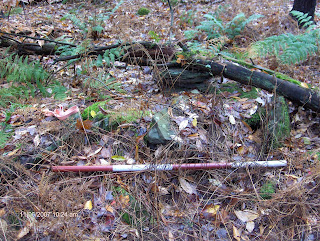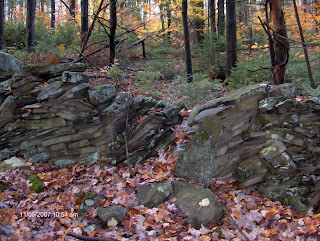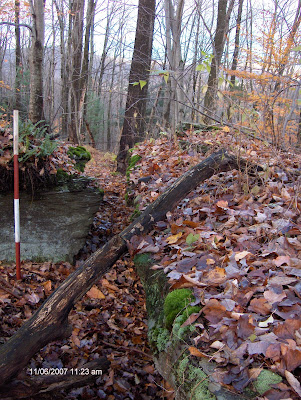I went back out to the Delaware State Forest today, to look at the large cairn field and also the steep bank with boulders, now that the leaves are off the trees. It's amazing how different it looks. But it's not just how the rocks look without shadows, it's also how I am looking at them as I am learning more and more about rock piles.
Instead of looking at two boulders for how they relate to each other, looking over one boulder and down to the next, I looked
between the boulders - pile-gap-pile - and guess what I noticed? I think it's a grid!
Here are some photos. If the measuring stick is in the photos, it's still my 4 foot stick with 1 foot increments. The meter stick is coming soon, I promise!
The bank is very steep. This photo looks down the rock wall that lies to the Northeast of the grid:

The picture doesn't really do the bank justice. The best way to describe it is by comparing it to downhill skiing. You know that feeling when you decide to go down a trail and you round the turn and all of a sudden the hill just drops off and all you can think is 'why did I come down
this trail?'. That's what it feels like when you stand at the top of this bank. It kind of makes you wonder why anyone would build a stone wall right here.
In the grid, looking through the 2 boulders as though they are pile-gap-pile:


Notice the pile in the foreground in the previous picture? Here is a close up of that pile. If you remove the tree and the years of accumulated leaf cover, I wonder if this was intended as an aperture?

Some of the piles on the other side of the two boulders:


When I was at this site the first time - when it was dark with leaf cover - I counted 9 piles as I stood in one spot.
This is looking down across 3 of the most prominent piles:


Here 2 shots of 2 of the piles, looking back toward the pile-gap-pile boulders. Notice the similar construction in the piles:


The last pile in the line of 3, which stood out the most, is actually rocks on a boulder. Notice how large they are:

And, I wonder if the aperture here is intended, as well?

This bank has a lot of features. I only focused on some of the more obvious piles in this post. Eventually, I will map as much of it as possible. Once I do, I'll post again on this site.
For now, I have some more photos of this area, which includes updates on the wall bulge and large cairns. As I keep going out to this site, I am able to see more, to gather more information, and to find things that I missed the first time I was out. Some of these things are very obvious and I wonder how I could have missed them the first time!






















































